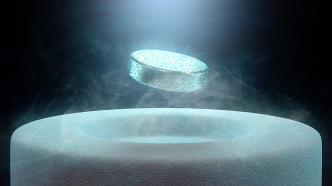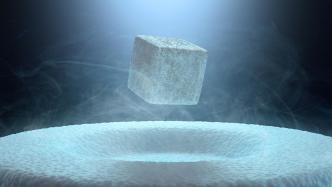
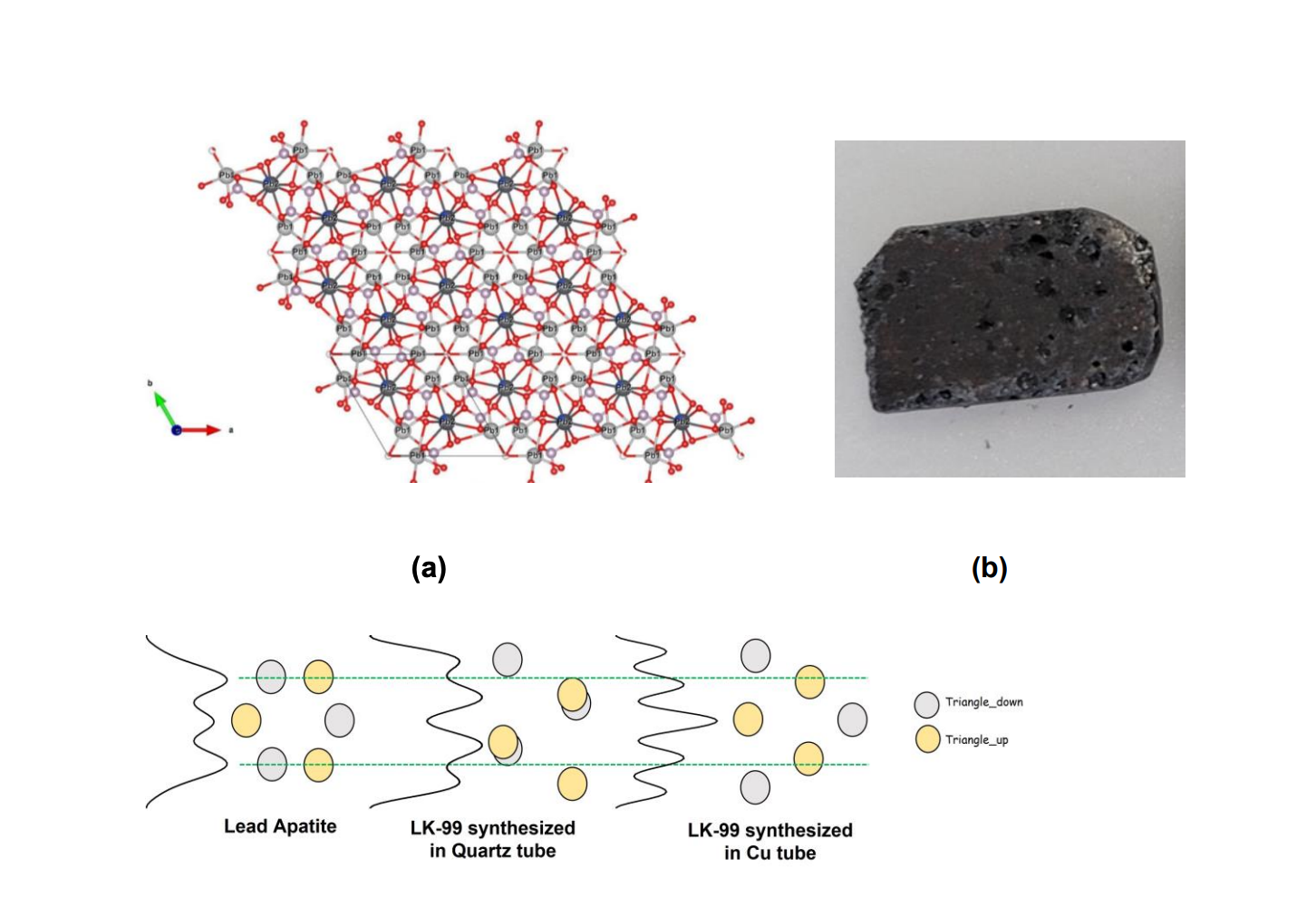
The LK-99 material (top right) demonstrated in the first Korean paper on room-temperature superconducting materials.
With regard to the recently hotly discussed "Korean room temperature superconducting material LK-99 paper" that can win the Nobel Prize immediately, on July 28, Wen Haihu, a professor at the School of Physics of Nanjing University, told The Paper that "It's really lively, but it's not surprising, because this matter is very important." "Most (hotly discussed) people don't do superconductivity." "We carefully analyzed their data from three aspects—— Resistance, magnetization, and so-called magnetic levitation are not enough to explain that it is a superconducting phenomenon (material)." "We judge (its so-called superconductivity) is very likely to be an illusion ."

Wen Haihu, a professor at the School of Physics of Nanjing University, is engaged in the research of high-temperature superconducting materials and physical problems.
Regarding the repeated experiment, Wen Haihu said, "Actually, we didn't want to do it, because we judged that it was not like superconducting, and later sent a classmate to do it. Many groups in the world are repeating it. Based on our experience, ( The data published in the current paper) is not enough to show that it is superconducting."
Is there really a material that can enter a superconducting state at room temperature and pressure?
Wen Haihu said that the existence is not ruled out . "But this is a very ambitious goal. As for whether we can see it in our lifetime , I don't know. So now that the results in South Korea are out, everyone is very excited. If it is true, everyone is very happy. But the current evidence is not enough to prove It's a superconducting material."
Regarding the reproduction of the results of the aforementioned Korean scientific research paper by the Institute of Physics of the Chinese Academy of Sciences on the Internet, Wen Haihu said that he has not seen the results so far. Even if it is reproduced, it cannot prove that it is a superconducting material unless the evidence for judging superconductivity is very clear. . "This material is easy to make (repeatedly made). I estimate that after two or three days, such as next week, many groups will make (results) and (then) immediately be able to judge whether it is superconducting."
On the 27th, the WeChat public account of the Institute of Physics of the Chinese Academy of Sciences replied to a relevant message saying, "There is no news about the completion of relevant experiments, please refer to the published papers."
The world's first room temperature and atmospheric pressure superconducting material that can immediately win the Nobel Prize?
At 7:51 on July 22, a research article entitled "The First Room-Temperature Ambient-Pressure Superconductor" (The First Room-Temperature Ambient-Pressure Superconductor) was published on the preprint website arXiv.
The paper was uploaded by Young-Wan Kwon, a professor at Korea University.
The first author of the paper, Sukbae Lee, and the second author, Ji-Hoon Kim, are both researchers at the Quantum Energy Research Center in South Korea, but the company's official website is currently blocked due to too many visitors.
Quan Yongwan is the third author of the aforementioned paper.
"For the first time in the world, we have successfully synthesized a room-temperature superconductor (Tc≥400 K, 127°C) working at normal pressure, and its structure is modified lead apatite (LK-99)." The aforementioned article said, "The critical temperature (Tc), zero resistivity, critical current (Ic), critical magnetic field (Hc), and the Meissner effect demonstrate the superconductivity of LK-99".
And 2.5 hours after the publication of the above paper, at 10:11 on July 22, another paper on the same topic "Superconductor Pb10-xCux(PO4)6O Suspension Phenomenon and Its Mechanism at Room Temperature and Atmospheric Pressure" (Superconductor Pb10−xCux(PO4)6O showing levitation at room temperature and atmospheric pressure and mechanism) was also submitted to the arXiv website. Compared with the paper published earlier, the latter is considered to be more rigorous, and the description of the preparation process of the material sample is more detailed and sufficient, but some annotations are still in Korean.
The second paper has 6 signed authors. Quan Yongwan was excluded from the list of signed authors, and it was considered that due to "internal strife", two papers were uploaded hastily.
The second paper was uploaded by the third author, Hyun tak Kim, a research professor of physics at the College of William & Mary in the United States. This paper has the same first and second authors as the first paper, but the remaining three authors of the second paper are Sungyeon Im, SooMin An, and Keun Ho Auh.
The "protagonist" of the aforementioned two papers, LK-99, is a copper-doped lead apatite. Wherein, the ratio of copper doping is between 0.9-1.1.
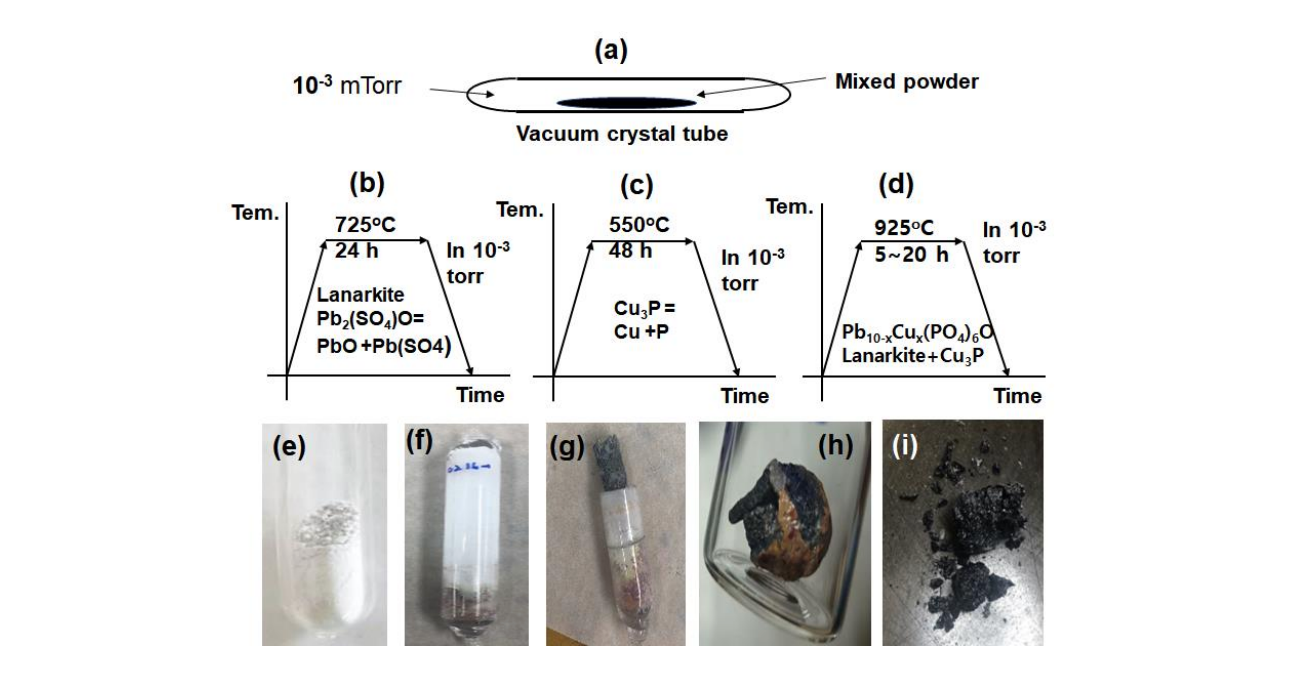
The method of "refining" the materials of LK-99.
The second research paper gave its detailed synthesis steps, which was dubbed "Alchemy" by netizens: " The first step is to synthesize chalcopyrite through chemical reactions...; the second step is to synthesize cuprous phosphide crystals...; In the third step , chalkite and cuprous phosphide crystals are ground into powder, mixed in a crucible, and then sealed into a thyristor with a vacuum of 10^-3 Torr (torr, equivalent to mmHg). The sealed tube with the mixed powder is heated in a furnace at 925 degrees Celsius for 5-20 hours. During this process, the mixture reacts and transforms into the final material."
In order to show that the experimental results are reliable, Jin Xuande uploaded a video at 3:31 am on July 26. The video shows that an irregular cylindrical sheet is placed on top of the magnet, and one side of the sheet can be clearly seen to be warped. , suspended in the air, showing "partial suspension". At present, the number of video views has exceeded 730,000.
In addition, public information shows that the aforementioned researchers had applied for an international patent for LK-99 as early as August 2022, and the patent was granted in March 2023.
The official website of the Korea Quantum Energy Research Center shows that the company's "headquarters and affiliated research institutes are located on the B1 floor, No. 46-24, Songro 23rd Street, Songpa District, Seoul, South Korea. The street view image updated on Google Maps in March 2023 shows that the address It is a four-storey bungalow with an interior decoration shop on the first floor.
not real maglev
Wen Haihu is currently a professor at the School of Physics of Nanjing University and a fellow of the American Physical Society (APS Fellow). He is mainly engaged in the research of high-temperature superconducting materials and physical problems. The contribution to the research on iron-based superconductivity won the first prize of National Natural Science Award.
On March 15, only 8 days after Ranga Dias, a professor at the University of Rochester in the United States, announced the discovery of high-pressure room-temperature superconducting materials and published data at the annual meeting of the American Physical Society, the team led by Wen Haihu announced the duplication The experimental results overturned the research results of room temperature superconductivity of Diaz et al., causing a sensation.
The aforementioned research results of Professor Wen Haihu's team were published online on May 11 in the journal Nature: The nitrogen-doped lutetium hydride (also known as lutetium-hydrogen-nitrogen compound) they prepared did not show near-normal room temperature superconductivity.
On July 28, 2023, Wen Haihu told The Paper that the so-called maglev shown in the aforementioned paper and its video does not look like a real superconducting maglev. So it's not 'superconducting maglev', either a ferromagnetic - slightly ferromagnetic material made of, a fake looking maglev, or a material with (with) a little bit of diamagnetism, but no A levitation of 'superconducting diamagnetic'. Because it is completely different from superconducting magnetic levitation."
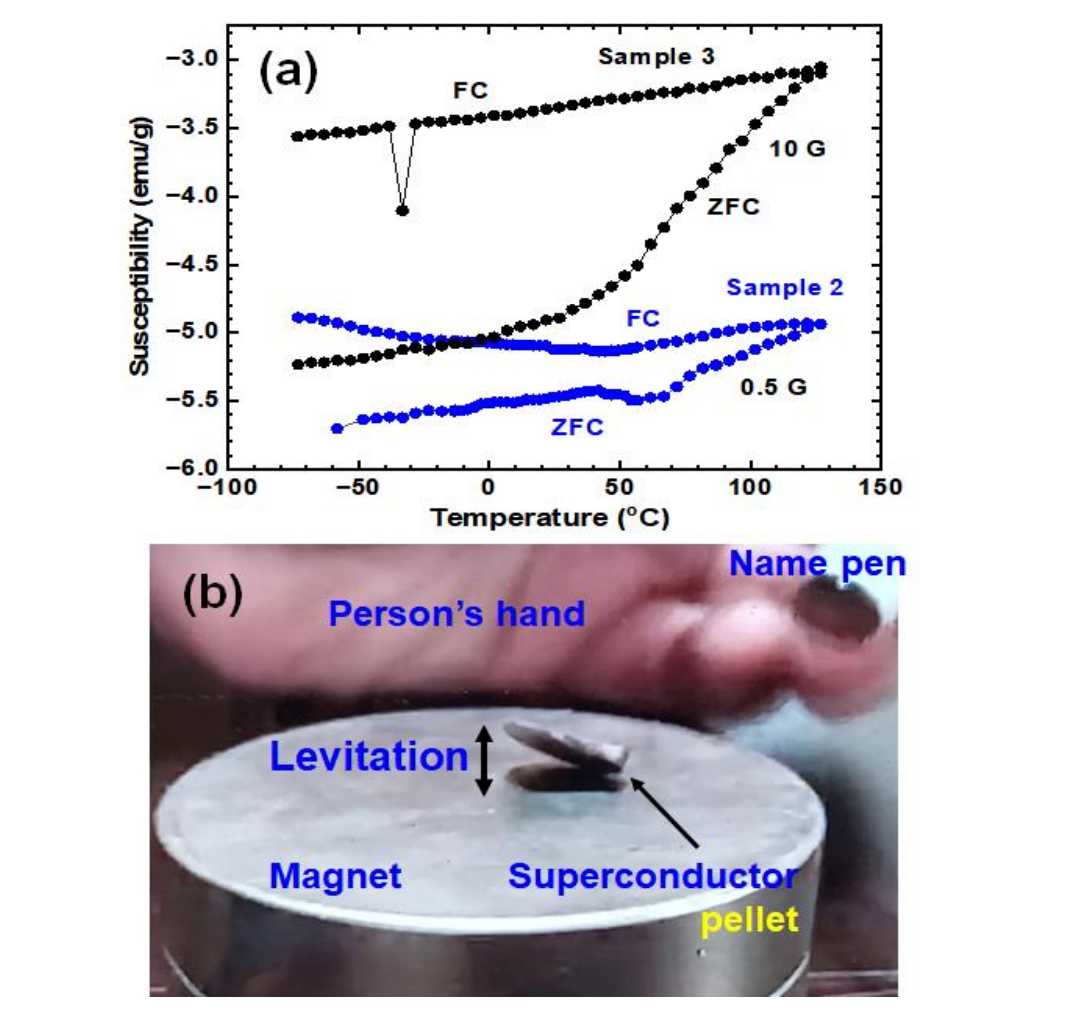
The "partially suspended" LK-99 (below).
Wen Haihu told The Paper that judging whether a material is a superconducting material depends on whether it can enter a superconducting state. "Your resistance should be measured very well, it must be true to 0, and then the magnetization must be truly measured to the Meissner state, instead of seeing a negative diamagnetic signal, it is said to be the Meissner state, because it may be If the measurement is wrong, it may be that the material itself is antimagnetic.”
Wen Haihu explained that when entering the superconducting state, the superconducting material does not allow any magnetic field to enter the body, and discharges all the magnetic field outside the body, which is called the Meissner effect. Because it wants to maintain the cleanliness of the "ordered society" formed by its internal electrons, because its electrons are paired in pairs to form a new order, which is very "unity" and does not want the magnetic field to destroy their "unity".
"But magnetic levitation is not the Meissner effect." "If you only measure a diamagnetism like the Korean paper, it is said that it is a Meissner state, not necessarily. Sometimes the instrument will lie to you, and the instrument itself will create false images. If people If you believe it, people will be deceived and think it is superconducting, but those who often do research on the magnetic properties of superconducting know how to distinguish it." Wen Haihu said.
People are looking forward to scientists really finding room temperature superconducting materials, but more voices of doubt are emerging.
Sam Altman, co-founder and CEO of the American artificial intelligence company OpenAI, commented, "I would like to believe it very much, but I think we are too excited about a two-magnet (diamagnet)."
"It's not superconductivity. It's experimental artefacts , wishful thinking and Poor judgment (at the best of times)."
According to a report by the technology news media "New Scientist" (New Scientist) on the 26th, Susannah Speller (Susannah Speller), a professor of materials at the University of Oxford, said that it is still too early to say that these samples can superconduct. When a material becomes superconducting, it should exhibit a well-defined signature in many measurements, she says. But two of those parameters—response to a magnetic field and a parameter called heat capacity—were not shown in the aforementioned paper.
"If it is really superconducting, what is its mechanism? It is the next step. Then, how are the electrons in this material paired, and why is the temperature so high (it can also be paired)? It is very interesting in science, but the first The first step is to prove that it is a superconductor."
Wen Haihu said that the mechanism of high-temperature superconductivity is not clear at present, and it is also known as a Nobel Prize-level research. "Many groups are working on this aspect." "If it is clear, it is also a major contribution to science."
Wen Haihu introduced that superconducting materials have actually been used in many industries, such as magnets for nuclear fusion research, magnets for nuclear magnetic imaging in hospitals, high-frequency filters, quantum computing, etc., are all used. But these are all using low-temperature superconducting materials. "Rotate-temperature superconductivity is a dream of everyone. If it is realized, there will be a big improvement in the applications just mentioned, reducing operating costs, etc., so it is something we dream of."
How to develop superconducting materials: China's layout and development
Wen Haihu introduced that in the research of superconducting materials, especially in the field of high-temperature superconducting, "Our country has a well-planned plan. It seems that Chinese scientists are still very rigorous and will not rashly announce something unreliable."
He introduced that the main domestic research institutions for superconducting materials and mechanisms include the Institute of Physics of the Chinese Academy of Sciences, as well as universities such as Peking University, Tsinghua University, Nanjing University, Fudan University, University of Science and Technology of China, and Zhejiang University, all of which have some good related research groups.

On the 27th, the WeChat official account of the Institute of Physics of the Chinese Academy of Sciences replied to a relevant message saying, "There is no news about the completion of relevant experiments."
"Temporary room temperature superconductivity may be being done. The Chinese Academy of Sciences has an intentional support, and other (institutional) research groups are working hard in this direction. Of course, the first step is high temperature superconductivity, and then realize room temperature as much as possible. In addition, the Foundation Committee , and the Ministry of Science and Technology’s projects are also funded.”
"Chinese scientists are still at the forefront in this area. For example, hydrogen-rich materials under high pressure are high-temperature superconductors, but high pressure is required. As for other high-temperature superconductors, recent work done by Sun Yat-sen University under lower pressure is reliable. Yes, it broke through the temperature of liquid nitrogen, but there is still a distance to reach room temperature. Everyone is working in this direction, but I don’t know when it will be realized.” Wen Haihu said.
Regarding low-temperature superconducting materials, Wen Haihu said that it is not surprising that many materials become superconducting under "normal pressure + low temperature". "Heat" is a damaging factor. At high temperatures, it is not in a superconducting state. As the temperature drops, at low temperatures, electrons pair up in pairs to form a "new society" before entering a superconducting state. "So superconductivity is a state. "
For high-voltage superconducting materials, Wen Haihu said that high pressure may cause a certain structural phase transition in the material. Under a specific structure, electrons form a paired stable state and eventually form superconductivity.
Wen Haihu said that research and development and search for superconducting materials, each research group has different scientific perspectives and has its own ideas, but the general direction is the same, such as which elements in the periodic table of elements are most likely, and which elements are likely to be combined Max, don't be too blind, "You can't burn blindly."
Wen Haihu explained that to form superconductivity, “you have to find a way to make two electrons pair up. Usually, electrons in metals conduct current with a single electron, so it has resistance. Then after you make electrons pair up, it forms A new electronic ordered state, an ordered society, is the society of 'electron pairing'. In the past, electrons 'do their own thing', but now they are paired and orderly, and there will be zero resistance, that is, superconductivity. Then how to cause two Electronic pairing? It can be the help of atomic vibration or magnetic interaction, and it is probably being explored under these two main ideas."
He said that there are so many elements in nature, mixed in two or three, forming thousands of materials. "You have to think, screen, and combine theoretical calculations to finally see if there is a possibility of high-temperature superconductivity. The current theory cannot describe it as accurately as possible. In this case, you can only do it according to your feelings, so it is difficult. Right here."
"There is no special suggestion. Work hard, don't be impetuous, and then report on the real superconducting phenomenon . I think this is the working attitude that a scientist should have." Wen Haihu said.
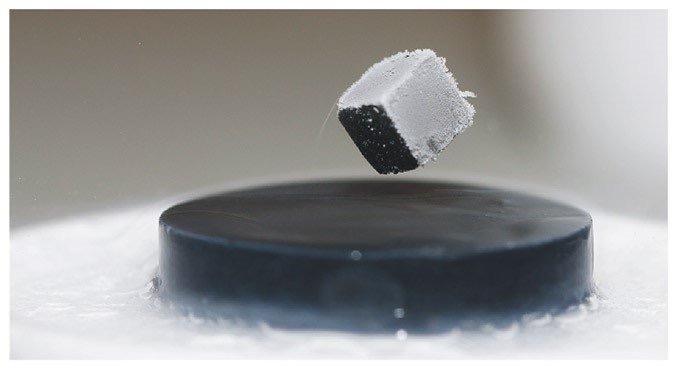
A cube of magnetic material is suspended above the superconductor. Map of Oak Ridge National Laboratory
Attached paper link:
1. https://arxiv.org/abs/2307.12008
2. https://arxiv.org/abs/2307.12037
3. https://sciencecast.org/casts/suc384jly50n
